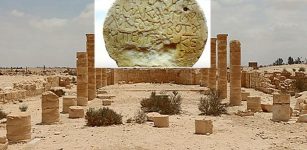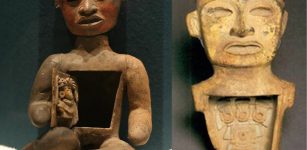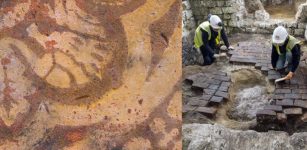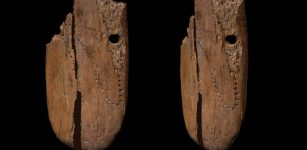Magnificent St. Paul’s Catacombs – Largest Underground Roman Cemetery In Malta
Conny Waters - AncientPages.com - St. Paul’s Catacombs provide us with the earliest archaeological evidence of Christianity in Malta.
The ancient Roman burial site is the largest and most impressive underground cemetery in the country. The site is open to the public and visitors can access over 20 of the catacombs in the St Paul's cluster.
A journey through this underground labyrinth of rock-cut tombs, narrow stairs, and passages gives a good understanding of ancient Roman and Phoenician burial traditions and customs.
St. Paul’s catacombs in Rabat, Malta. Credit: G.Mannaerts, CC BY-SA 4.0
It’s estimated the first burial here took place in the 3rd century B.C. and the tombs continued to be used until the 4th century A.D.
Not all of the tombs belong to Christians. Within this underground complex, there are also several Pagan and Jewish burials.
Covering an area of more than 2000 square meters, St. Paul’s Catacombs are part of a vast cemetery once located outside the walls of the ancient Greek city of Melite, present-day Mdina.
St. Paul's Catacombs in Rabat, Malta. Credit: Balazs Sudar, CC BY-SA 3.0
Melite started its existence as a Bronze Age settlement before the Phoenicians re-named it Maleth and turned it into the administrative center of the island.
In 218 B.C. Romans successfully captured the city and it remained part of the Roman and later the Byzantine Empire until 870 A.D.
St Paul’s probably started as a smaller underground catacomb complex before it was subsequently enlarged by joining up neighboring hypogea to serve as a communal burial space.
According to tradition, Phoenicians and Romans didn’t want to bury their dead within the city walls and St. Paul’s Catacombs grew in size over time.
Menorah indicating the presence of Jewish burials, Credit: G.Mannaerts, CC BY-SA 4.0
In the late 1800s, scientists started to excavate the massive underground complex and St. Paul’s Catacombs are today excellent documented providing us with cultural, artistic, and social climates of the ancient Mediterranean world. Unfortunately, all tombs were already looted, and no burial artifacts have been discovered.
The site consists of two large areas called St Paul’s and Saints Paul/Agatha consisting of more than 30 hypogea.
Inside the main burial space, you will find a great hall and the impressive Baldacchino free-standing tombs.
The reason this magnificent underground burial complex has been named St Paul's Catacombs is that a Church nearby has this name.
Written by Conny Waters – AncientPages.com Staff Writer
Copyright © AncientPages.com All rights reserved. This material may not be published, broadcast, rewritten or redistributed in whole or part without the express written permission of AncientPages.com
More From Ancient Pages
-
 10 Types Of Ancient Crosses In Different Cultures Explained
Featured Stories | May 23, 2017
10 Types Of Ancient Crosses In Different Cultures Explained
Featured Stories | May 23, 2017 -
 Tombstone With Ancient Greek Inscription Unearthed Near Nitzana In The Negev, Israel
Archaeology | Jan 8, 2021
Tombstone With Ancient Greek Inscription Unearthed Near Nitzana In The Negev, Israel
Archaeology | Jan 8, 2021 -
 Why Was Celebration Of Christmas, Easter, Midsummer And Saint’s Day Forbidden In Scotland?
Ancient History Facts | Dec 27, 2019
Why Was Celebration Of Christmas, Easter, Midsummer And Saint’s Day Forbidden In Scotland?
Ancient History Facts | Dec 27, 2019 -
 Medicine in Antiquity: From Ancient Temples To Roman Logistics
Archaeology | Apr 13, 2018
Medicine in Antiquity: From Ancient Temples To Roman Logistics
Archaeology | Apr 13, 2018 -
 Mysterious Teotihuacan ‘Host’ Figurines From Metepec, Mexico
Artifacts | Jan 6, 2016
Mysterious Teotihuacan ‘Host’ Figurines From Metepec, Mexico
Artifacts | Jan 6, 2016 -
 Mystery Of The Giant Laos Jars Continues – New Discoveries Reported By Scientists
Archaeology | Apr 19, 2021
Mystery Of The Giant Laos Jars Continues – New Discoveries Reported By Scientists
Archaeology | Apr 19, 2021 -
 Sacsayhuamán – Was It Built By ‘Demons’ Or Viracocha The Bearded God?
Civilizations | Apr 10, 2014
Sacsayhuamán – Was It Built By ‘Demons’ Or Viracocha The Bearded God?
Civilizations | Apr 10, 2014 -
 LIDAR Discovers 18-Kilometer (11-Mile) Maya Road In The Yucatan Jungle
Archaeology | Dec 5, 2023
LIDAR Discovers 18-Kilometer (11-Mile) Maya Road In The Yucatan Jungle
Archaeology | Dec 5, 2023 -
 Strange Mythical Creature Resembling A Sphinx Discovered In A Medieval Bathroom
Archaeology | Mar 10, 2020
Strange Mythical Creature Resembling A Sphinx Discovered In A Medieval Bathroom
Archaeology | Mar 10, 2020 -
 41,500-Year-Old Ivory Pendant Is The Oldest Evidence Of Humans Decorating Jewelery In Eurasia
Archaeology | Nov 26, 2021
41,500-Year-Old Ivory Pendant Is The Oldest Evidence Of Humans Decorating Jewelery In Eurasia
Archaeology | Nov 26, 2021 -
 King Tut’s Cosmic Scarab Brooch And Dagger Linked To Meteorite’s Crash 28 Million Years Ago
Artifacts | Jun 17, 2021
King Tut’s Cosmic Scarab Brooch And Dagger Linked To Meteorite’s Crash 28 Million Years Ago
Artifacts | Jun 17, 2021 -
 History Of Eyeglasses: One Of The Most Important Inventions Is Lost To History
Ancient Technology | Mar 10, 2016
History Of Eyeglasses: One Of The Most Important Inventions Is Lost To History
Ancient Technology | Mar 10, 2016 -
 Science Fiction Was Around In Medieval Times – Here’s What It Looked Like
Featured Stories | Sep 18, 2018
Science Fiction Was Around In Medieval Times – Here’s What It Looked Like
Featured Stories | Sep 18, 2018 -
 Ivan The Terrible: Military Arsenal Unearthed Near Moscow
Archaeology | Jan 2, 2016
Ivan The Terrible: Military Arsenal Unearthed Near Moscow
Archaeology | Jan 2, 2016 -
 Radar Discovery Of Unknown Viking Age Stone Ship, Burial Mounds And Houses In The Trondheim Fjord
Archaeology | Mar 28, 2023
Radar Discovery Of Unknown Viking Age Stone Ship, Burial Mounds And Houses In The Trondheim Fjord
Archaeology | Mar 28, 2023 -
 Ancient DNA Reveals Hunter-Gatherers From Mexico Moved To California 5,200 Years Ago
DNA | Nov 29, 2023
Ancient DNA Reveals Hunter-Gatherers From Mexico Moved To California 5,200 Years Ago
DNA | Nov 29, 2023 -
 Playful Puck (Robin Goodfellow) – Master Of Harmless Mischief And Shakespeare’s Visit To The Magic Valley
Myths & Legends | Jun 24, 2021
Playful Puck (Robin Goodfellow) – Master Of Harmless Mischief And Shakespeare’s Visit To The Magic Valley
Myths & Legends | Jun 24, 2021 -
 Great research of Polish archaeologist working at rock art site in Kondoa, Tanzania
News | Aug 26, 2015
Great research of Polish archaeologist working at rock art site in Kondoa, Tanzania
News | Aug 26, 2015 -
 Pharaoh Apries – Was The Betrayed Egyptian King Murdered By His Own People?
Featured Stories | Jun 30, 2021
Pharaoh Apries – Was The Betrayed Egyptian King Murdered By His Own People?
Featured Stories | Jun 30, 2021 -
 Evidence Of Ancient Gigantic Tsunami That Struck Tel Dor Maritime City Mound, Israel
News | Jan 1, 2021
Evidence Of Ancient Gigantic Tsunami That Struck Tel Dor Maritime City Mound, Israel
News | Jan 1, 2021



